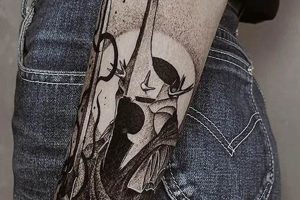Designs inspired by Indigenous American cultures encompass a wide range of visual elements, including depictions of animals, nature-inspired patterns, spiritual symbols, and traditional art forms. A stylized bear might represent strength, while a feather could symbolize honor. These designs often carry deep cultural significance connected to specific tribes and their traditions.
Connecting with ancestral heritage, expressing personal identity, and appreciating the artistic traditions of Indigenous peoples are potential motivations for exploring such body art. The rich history and symbolism embedded within these designs can offer a powerful means of storytelling and cultural preservation. It is crucial, however, to approach such designs with respect and understanding, acknowledging their cultural significance and avoiding appropriation.
Further exploration of specific tribal traditions, appropriate design consultations, and ethical considerations will be addressed in subsequent sections. Understanding the meaning and protocols associated with specific imagery is paramount to ensuring respectful and meaningful representations.
1. Tribal Affiliation
Tribal affiliation plays a crucial role in the appropriate selection and interpretation of designs inspired by Indigenous American cultures. Specific symbols, patterns, and artistic styles often hold deep meaning within the context of a particular tribe’s history, beliefs, and traditions. A design that holds significance for one tribe might be entirely different or even inappropriate for another. For instance, certain animal depictions might represent clan lineages or spiritual guides, varying significantly across tribal nations. Therefore, understanding the specific cultural context associated with a design is essential to avoid misrepresentation or disrespect.
Researching and acknowledging tribal affiliation demonstrates respect for Indigenous heritage and ensures the chosen design carries its intended meaning. This understanding fosters a deeper appreciation for the rich cultural narratives embedded within these artistic traditions. Choosing a design based solely on aesthetics, without considering its cultural origin and significance, can lead to unintentional misappropriation and perpetuate harmful stereotypes. Consulting with members of the specific tribe or reputable cultural experts is crucial for navigating these complexities and ensuring respectful representation.
Respectful engagement with Indigenous-inspired designs requires diligent research and sensitivity towards tribal affiliations. Acknowledging the unique cultural context associated with specific symbols and artistic styles helps prevent the misappropriation of sacred traditions and promotes a more meaningful appreciation of Indigenous art forms. By understanding the importance of tribal affiliation, individuals can contribute to the preservation and respectful representation of diverse Indigenous cultures.
2. Symbolism and Meaning
Symbolism lies at the heart of designs inspired by Indigenous American cultures. Each element carries deep cultural, spiritual, and historical significance, reflecting the intricate relationship between Indigenous peoples and their ancestral traditions. Understanding this symbolism is paramount for ensuring respectful and meaningful representation.
- Animal Representations
Animals often embody specific traits or spiritual concepts. The bear, for instance, might symbolize strength and protection, while the eagle represents freedom and connection to the spirit world. Depictions of specific animals vary significantly across tribes, reflecting diverse cultural narratives and beliefs. Thorough research is essential to understand the appropriate representation of animals within a specific tribal context.
- Nature-Inspired Imagery
Elements from the natural world, such as feathers, mountains, and water, hold profound meaning within Indigenous cultures. Feathers can symbolize honor, spirituality, or connection to ancestors. Mountains represent strength and grounding, while water signifies life and purification. The interpretation of these elements can vary across different tribal traditions, emphasizing the need for culturally informed understanding.
- Geometric Patterns and Shapes
Geometric patterns often reflect complex cosmological beliefs, clan lineages, or spiritual narratives. These designs can incorporate intricate symbolism related to tribal identity, social status, or personal experiences. Understanding the specific meanings associated with these patterns requires careful research and consultation with cultural experts from the relevant tribe.
- Spiritual and Ceremonial Symbols
Certain symbols hold deep spiritual significance and are often associated with specific ceremonies or rituals. These symbols might represent powerful spiritual concepts, ancestral connections, or protective energies. Approaching these symbols with respect and understanding their ceremonial context is crucial to avoid cultural insensitivity.
Careful consideration of these symbolic elements ensures that designs inspired by Indigenous American cultures are approached with respect and authenticity. Engaging with knowledgeable resources and demonstrating cultural sensitivity contributes to the preservation and appreciation of these rich artistic traditions.
3. Artist Consultation
Collaboration with Indigenous tattoo artists specializing in tribal designs is paramount when considering body art inspired by Native American cultures. This consultation process ensures respectful representation, accurate symbolism, and contributes to the preservation of authentic artistic traditions. Direct engagement with Indigenous artists fosters a deeper understanding of the cultural significance embedded within these designs.
- Cultural Sensitivity and Understanding
Indigenous artists possess intricate knowledge of their own cultural heritage, ensuring designs are approached with appropriate sensitivity and respect. They can advise on the cultural appropriateness of specific symbols, patterns, and artistic styles, preventing unintentional misrepresentation or offense. This cultural understanding safeguards against the perpetuation of harmful stereotypes and promotes accurate representation.
- Authentic Design and Technique
Collaborating with Indigenous artists ensures the chosen design reflects authentic tribal traditions. They possess the expertise to execute traditional techniques and incorporate culturally specific elements, guaranteeing the design’s integrity and accuracy. This collaboration contributes to the preservation of ancestral art forms and prevents the dilution of cultural heritage.
- Meaningful Storytelling and Personalization
Indigenous artists can facilitate a deeper connection to the chosen design by incorporating elements that resonate with an individual’s personal journey or ancestral heritage. They can help translate personal narratives into meaningful visual representations, creating a powerful and culturally resonant piece of body art. This personalized approach enhances the significance and emotional impact of the design.
- Supporting Indigenous Artists and Communities
Commissioning artwork from Indigenous artists directly supports their livelihoods and contributes to the economic empowerment of Indigenous communities. This economic support helps sustain cultural practices and ensures the continuation of traditional art forms for future generations. Choosing Indigenous artists over non-Indigenous artists actively promotes cultural preservation and economic justice.
By prioritizing consultation with Indigenous tattoo artists, individuals demonstrate a commitment to respectful representation, cultural preservation, and ethical engagement with Native American traditions. This collaborative approach elevates the process beyond mere aesthetics, transforming it into a meaningful and culturally enriching experience.
4. Authenticity and Respect
Authenticity and respect are paramount when considering designs inspired by Native American cultures. These concepts serve as guiding principles, ensuring that the rich history, symbolism, and artistic traditions of Indigenous peoples are honored and not exploited. Approaching these designs with a deep understanding of their cultural significance is crucial for avoiding misappropriation and perpetuating harmful stereotypes.
- Research and Understanding
Thorough research into the specific cultural context of a chosen design is essential. This involves understanding the history, beliefs, and artistic practices of the relevant tribe. For example, researching the symbolism of a particular animal within a specific tribal tradition ensures accurate representation and avoids misinterpretations. This commitment to research demonstrates respect for Indigenous knowledge and prevents the misappropriation of sacred symbols.
- Avoiding Generic Representations
Generic “pan-Indian” depictions that lack specific tribal affiliation often perpetuate stereotypes and erase the unique cultural identities of individual tribes. Authentic designs are rooted in specific tribal traditions, reflecting the distinct artistic styles and symbolic meanings associated with a particular culture. Choosing designs that are tribally specific honors the diversity of Indigenous cultures and avoids homogenizing representations.
- Intent and Motivation
The motivation behind choosing a design inspired by Native American cultures should stem from genuine appreciation and respect, not superficial aesthetics or trends. Understanding the deep cultural significance associated with these designs is crucial. Wearing a design solely for its aesthetic appeal, without acknowledging its cultural context, constitutes appropriation and disrespects Indigenous heritage.
- Consultation and Collaboration
Seeking guidance from Indigenous artists and cultural experts is essential throughout the design process. This collaboration ensures accurate representation, respectful interpretation, and contributes to the preservation of authentic artistic traditions. Direct engagement with Indigenous communities demonstrates a commitment to ethical practices and fosters a deeper understanding of cultural nuances.
Authenticity and respect must remain central to any engagement with designs inspired by Native American cultures. These principles ensure that these powerful art forms are appreciated and honored in a way that preserves their cultural integrity and contributes to the ongoing revitalization of Indigenous traditions.
5. Cultural Appropriation
Cultural appropriation, particularly concerning designs inspired by Indigenous American cultures, raises complex ethical considerations. Adopting elements of a marginalized culture without understanding or respecting their original context trivializes their significance and perpetuates historical power imbalances. This section explores the multifaceted nature of cultural appropriation as it relates to these designs.
- Commodification of Sacred Symbols
Transforming sacred symbols and traditional designs into commodities for personal adornment detaches them from their spiritual and cultural significance. For instance, wearing a headdress, an item of immense spiritual importance in many Indigenous cultures, as a fashion accessory trivializes its meaning and disrespects the traditions it represents. This commodification reduces complex cultural practices to mere aesthetics, erasing their historical and spiritual depth.
- Perpetuation of Stereotypes
Generic, stereotypical representations of Indigenous cultures, often seen in commercialized “Native-inspired” designs, reinforce harmful misconceptions. These simplified and inaccurate depictions contribute to the erasure of individual tribal identities and perpetuate a homogenized view of diverse cultures. For example, using generalized “tribal” patterns without acknowledging their specific tribal origins contributes to the misconception of a singular, monolithic Indigenous identity.
- Disrespect of Tribal Ownership
Many designs and symbols hold specific meaning and significance within particular tribal contexts. Using these designs without understanding or acknowledging their tribal origins disrespects the cultural ownership and intellectual property rights of Indigenous communities. This disregard for tribal ownership perpetuates the historical pattern of cultural exploitation and erasure.
- Power Imbalances and Historical Context
Cultural appropriation occurs within a historical context of colonization, oppression, and ongoing systemic inequalities. Adopting elements of a marginalized culture without understanding this historical context reinforces existing power imbalances and perpetuates the marginalization of Indigenous voices. It is crucial to acknowledge the historical power dynamics at play and approach these designs with sensitivity and respect.
Understanding the nuances of cultural appropriation is crucial for anyone considering designs inspired by Native American cultures. Respectful engagement requires thorough research, consultation with Indigenous artists and communities, and a deep understanding of the historical and cultural context surrounding these powerful art forms. Choosing designs that honor, rather than exploit, Indigenous heritage contributes to cultural preservation and promotes respectful intercultural dialogue.
Careful consideration is crucial when exploring body art inspired by Indigenous American cultures. These tips offer guidance for navigating the complexities of design selection, artist collaboration, and cultural sensitivity.
Tip 1: Prioritize Research and Cultural Understanding: Thorough research into specific tribal affiliations, symbolic meanings, and artistic traditions is paramount. Understanding the cultural context prevents misrepresentation and demonstrates respect for Indigenous heritage. For instance, researching the symbolism of a bear within a specific tribe’s traditions ensures its accurate and respectful depiction.
Tip 2: Seek Guidance from Indigenous Artists: Collaborating with Indigenous tattoo artists specializing in tribal designs ensures authenticity and cultural sensitivity. Their expertise provides invaluable insights into appropriate design elements and traditional techniques, fostering respectful representation and supporting Indigenous artists directly.
Tip 3: Avoid Generic or “Pan-Indian” Designs: Generic representations erase the unique cultural identities of individual tribes and perpetuate harmful stereotypes. Prioritize designs rooted in specific tribal traditions, reflecting the distinct artistic styles and symbolic meanings associated with a particular culture.
Tip 4: Focus on Meaning and Personal Connection: Designs should hold personal significance and resonate with individual experiences, while remaining respectful of cultural protocols. Collaborate with an Indigenous artist to translate personal narratives into meaningful visual representations that honor both individual and cultural heritage.
Tip 5: Understand and Avoid Cultural Appropriation: Recognize the historical context of colonization and ongoing systemic inequalities impacting Indigenous communities. Avoid commodifying sacred symbols or using designs solely for aesthetic appeal without acknowledging their cultural depth and significance.
Tip 6: Respect Tribal Ownership and Intellectual Property: Acknowledge and respect the cultural ownership of specific designs and symbols. Avoid using designs without understanding their tribal origins and obtaining appropriate permissions, if necessary, to honor Indigenous intellectual property rights.
Tip 7: Engage in Ongoing Learning and Reflection: Cultural understanding is an ongoing process. Continue learning about Indigenous cultures, artistic traditions, and the evolving conversations surrounding cultural appropriation. Regular reflection ensures continued respect and sensitivity.
By adhering to these guidelines, individuals can approach designs inspired by Native American cultures with respect, authenticity, and a deep appreciation for the rich traditions they represent.
The following concluding section synthesizes these key points and reinforces the importance of responsible engagement with Indigenous-inspired body art.
Frequently Asked Questions about Designs Inspired by Indigenous American Cultures
This section addresses common inquiries and potential misconceptions regarding body art inspired by Indigenous American traditions, offering further clarity on respectful engagement and cultural sensitivity.
Question 1: How can one ensure respectful representation when choosing a design inspired by Indigenous American cultures?
Respectful representation necessitates thorough research into the specific tribal affiliation associated with the design. Understanding the cultural and historical context of the chosen symbolism is crucial, as is consulting with Indigenous artists or cultural experts to ensure accuracy and avoid misappropriation.
Question 2: What are the ethical implications of using Indigenous imagery without tribal affiliation?
Using Indigenous imagery without understanding or acknowledging its tribal origins disrespects cultural ownership and perpetuates harmful stereotypes. It can contribute to the erasure of unique tribal identities and reinforce a homogenized, inaccurate view of diverse Indigenous cultures.
Question 3: Why is consulting with an Indigenous tattoo artist important?
Indigenous artists possess invaluable cultural knowledge and artistic expertise. Their guidance ensures authentic designs, accurate symbolism, and respectful representation. Collaborating with them directly also supports Indigenous artists and communities.
Question 4: What constitutes cultural appropriation in the context of these designs?
Cultural appropriation involves adopting elements of a marginalized culture without understanding or respecting their original context. Commodifying sacred symbols, perpetuating stereotypes, and disregarding tribal ownership are examples of cultural appropriation.
Question 5: Are there specific designs or symbols that should be avoided entirely?
Headdresses, sacred ceremonial objects, and other culturally significant items should generally be avoided as tattoo designs. These items hold deep spiritual meaning within specific tribal contexts and should not be trivialized through personal adornment.
Question 6: How can one contribute to the preservation and appreciation of Indigenous cultures through body art?
Supporting Indigenous artists, engaging in respectful dialogue, and promoting accurate cultural representation contribute to cultural preservation. Choosing designs that honor, rather than exploit, Indigenous heritage helps ensure these traditions are respected and valued.
Careful consideration of these questions and continued learning are essential for ensuring respectful engagement with designs inspired by Indigenous American cultures. Approaching these artistic traditions with sensitivity and understanding contributes to their preservation and honors the rich heritage they represent.
This resource serves as a starting point for further exploration of Indigenous art and cultural appreciation. Continued learning and respectful engagement are encouraged.
Conclusion
Exploring designs rooted in Indigenous American traditions requires careful navigation of cultural significance, artistic authenticity, and ethical considerations. Respectful engagement necessitates thorough research, consultation with Indigenous artists, and a deep understanding of tribal affiliations and symbolism. Avoiding cultural appropriation, prioritizing meaningful representation, and supporting Indigenous artists are crucial aspects of this process. Authenticity and respect for Indigenous heritage must remain paramount throughout every stage, from initial concept to final execution.
These artistic traditions offer a powerful means of storytelling, cultural preservation, and personal expression. Approaching them with sensitivity and a commitment to ongoing learning ensures their continued vitality and honors the rich heritage they represent. Further exploration of Indigenous art, history, and contemporary issues remains essential for fostering respectful intercultural dialogue and understanding.







